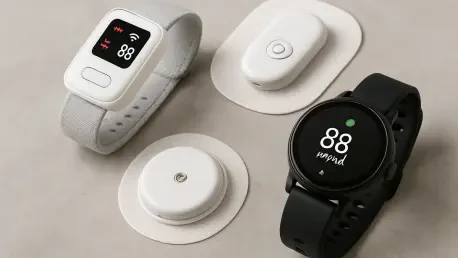In a world where healthcare is increasingly driven by technology, wearable medical devices are emerging as game-changers, empowering patients and clinicians with tools that monitor health in real time. These devices, spanning smartwatches, biosensors, and even implantable technologies, have evolved far beyond simple fitness trackers to become integral parts of medical care. With the market projected to skyrocket from USD 57.56 billion in 2024 to USD 499.2 billion by 2035, at a compound annual growth rate of 21.6%, the impact of wearables on healthcare delivery is undeniable. This remarkable growth reflects a shift toward proactive, personalized health management, addressing pressing global challenges like chronic diseases and aging populations. As these tools integrate cutting-edge advancements, they are redefining how health is monitored, managed, and improved across diverse regions and demographics.
The significance of wearable devices lies in their ability to bridge gaps in traditional healthcare systems by enabling continuous monitoring and remote data sharing. This innovation reduces the burden on hospitals while enhancing patient outcomes through timely interventions. From detecting irregular heart rhythms to tracking glucose levels, the potential to intervene early is transforming lives. Yet, amidst this rapid adoption, challenges such as cost, data security, and regulatory compliance loom large. Exploring these dynamics reveals not just the current state of wearables but also the opportunities and hurdles that will shape their role in the future of medicine.
The Power of Technology in Wearables
Harnessing AI and IoT for Health Insights
The integration of artificial intelligence (AI) and the Internet of Things (IoT) into wearable medical devices is revolutionizing health monitoring with unprecedented precision, marking a significant leap forward in personalized healthcare. AI algorithms analyze vast amounts of data collected from wearables, identifying patterns that predict potential health issues before symptoms manifest. For instance, a smartwatch equipped with AI can detect anomalies in heart rate variability, alerting users and their doctors to possible cardiovascular risks. Meanwhile, IoT ensures seamless connectivity, allowing data to flow instantly between patients, healthcare providers, and systems. This interconnectedness means a patient’s vital signs can be monitored in real time, even from thousands of miles away, facilitating immediate responses to critical changes. The synergy of these technologies is driving a new era of predictive and responsive care that prioritizes prevention over reaction.
Beyond prediction and connectivity, the role of AI and IoT extends to personalizing healthcare experiences through wearables. Machine learning models adapt to individual user data, tailoring health recommendations based on unique physiological profiles. This customization is vital for managing conditions like diabetes, where personalized alerts for blood sugar fluctuations can prevent emergencies. Additionally, IoT-enabled devices integrate with broader health ecosystems, syncing with electronic medical records to provide clinicians with comprehensive patient histories. This holistic approach not only improves diagnostic accuracy but also fosters stronger patient-provider collaboration. As these technologies advance, their ability to refine and expand the capabilities of wearables continues to reshape healthcare delivery on a global scale.
Cloud Platforms and Data Security
Cloud-based platforms are a cornerstone of wearable medical devices, enabling secure storage and real-time analysis of health data across vast networks. These systems allow wearables to upload information instantly, giving healthcare providers access to up-to-date patient metrics regardless of location. For example, a cloud-connected wearable tracking respiratory patterns can transmit data to a pulmonologist, facilitating timely adjustments to treatment plans without an in-person visit. This scalability is particularly valuable in telemedicine, where cloud integration supports virtual consultations and remote monitoring for patients in underserved areas. The efficiency and accessibility offered by cloud technology are accelerating the adoption of wearables as essential tools in modern healthcare frameworks.
However, with the benefits of cloud platforms come significant concerns about data security and privacy in wearable devices. The sensitive nature of health information necessitates robust safeguards to comply with stringent regulations like HIPAA in the U.S. and GDPR in Europe. Breaches in data protection can erode trust in wearable technology, deterring both patients and providers from embracing these innovations. Manufacturers are increasingly prioritizing encryption and secure authentication protocols to mitigate risks, but challenges persist as cyber threats evolve. Balancing the convenience of cloud connectivity with the imperative to protect personal health data remains a critical focus for industry stakeholders, ensuring that the transformative potential of wearables is not undermined by vulnerabilities.
Addressing Global Health Challenges
Managing Chronic Diseases
Wearable medical devices are proving indispensable in tackling the global burden of chronic diseases, which affect millions and strain healthcare systems worldwide. Conditions such as diabetes, hypertension, and heart disease require consistent monitoring, a need that wearables meet through non-invasive, user-friendly solutions. Devices like continuous glucose monitors provide real-time blood sugar readings, empowering patients to manage their condition with greater autonomy while reducing the risk of severe complications. Similarly, wearable ECG monitors detect irregular heart rhythms, enabling early interventions that prevent life-threatening events. By offering actionable insights directly to patients and clinicians, these tools are shifting chronic care from episodic treatment to continuous management, ultimately improving quality of life.
The economic impact of wearables in chronic disease management cannot be overstated, as they help curb the high costs associated with hospital readmissions and emergency care. For healthcare providers, integrating data from these devices into treatment plans enhances decision-making and optimizes resource allocation. Patients benefit from reduced travel to medical facilities, particularly in remote or rural areas where access to specialists is limited. Furthermore, the ability of wearables to track multiple health parameters simultaneously—such as blood pressure alongside heart rate—offers a comprehensive view of a patient’s condition. This multi-dimensional approach ensures that chronic diseases are managed holistically, addressing both immediate symptoms and long-term health trends with precision.
Supporting Aging Populations
As populations age, particularly in regions like North America and Europe, wearable medical devices are becoming vital for ensuring the safety and well-being of seniors, who often face increased risks of falls, mobility issues, and chronic health conditions. These challenges can be effectively monitored through wearables. Devices equipped with fall detection technology can automatically alert emergency contacts or medical services when a fall occurs, providing peace of mind for both seniors and their families. Additionally, wearables that track vital signs like heart rate and oxygen levels help detect early signs of deterioration, enabling timely medical interventions. This proactive monitoring supports independent living, reducing the need for constant supervision or institutional care.
Beyond immediate safety, wearables tailored for aging populations contribute to long-term health management by fostering engagement in personal wellness. Activity trackers encourage seniors to maintain physical activity within safe limits, combating sedentary lifestyles that exacerbate health issues. Data from these devices can also be shared with healthcare providers to adjust care plans, ensuring treatments remain relevant as needs evolve. In regions with growing elderly demographics, the scalability of wearables offers a sustainable solution to the rising demand for healthcare services. By alleviating pressure on hospitals and caregivers, these technologies are not only enhancing individual outcomes but also addressing systemic challenges in aging societies with innovative, accessible tools.
Regional Dynamics and Market Growth
North America’s Leadership
North America stands at the forefront of wearable medical device adoption, driven by its advanced healthcare infrastructure and early embrace of digital health solutions. The region benefits from a robust ecosystem of technology innovators, supportive reimbursement policies, and a high level of consumer awareness about health tech. Hospitals and clinics across the U.S. and Canada are increasingly integrating wearables into patient care, using data from devices like smartwatches to monitor recovery and prevent complications. This leadership is further bolstered by significant investments in research and development, ensuring that North American companies remain at the cutting edge of wearable innovation. The result is a market where both clinical-grade and consumer-grade devices are widely accepted as essential components of healthcare delivery.
The dominance of North America also stems from a strong regulatory framework that, while stringent, provides clear pathways for device approval and market entry, ensuring that innovations can reach the public efficiently. Agencies like the U.S. FDA prioritize safety and efficacy, fostering trust among users and providers. Additionally, partnerships between tech giants and healthcare institutions are accelerating the deployment of wearables in clinical settings, from remote patient monitoring to post-surgical care. This collaborative environment not only drives adoption but also sets global standards for wearable integration. As a result, North America serves as a benchmark for other regions, demonstrating how infrastructure, policy, and innovation can converge to maximize the impact of health-focused technologies.
Asia-Pacific’s Rapid Rise
The Asia-Pacific region is experiencing the fastest growth in the wearable medical device market, fueled by rapid healthcare digitalization and escalating health challenges. Countries like China, India, and Japan are witnessing a surge in chronic disease prevalence, necessitating scalable monitoring solutions that wearables provide. Governments and private sectors in these nations are investing heavily in telemedicine and digital health platforms, creating fertile ground for wearable adoption. For instance, in densely populated areas where access to healthcare facilities is limited, devices that enable remote monitoring are bridging critical gaps. This momentum positions Asia-Pacific as a powerhouse of future market expansion, with growth rates outpacing more established regions.
Cultural shifts toward preventive health and rising disposable incomes are further accelerating the uptake of wearables in the Asia-Pacific region. Consumers are increasingly purchasing consumer-grade devices for fitness and wellness tracking, while clinical-grade wearables gain traction in hospital partnerships. Local manufacturers are also stepping up, producing cost-effective devices tailored to regional needs, which helps address affordability concerns. Moreover, international companies are entering these markets through strategic alliances with local providers, ensuring products align with cultural and systemic nuances. This dynamic blend of demand, investment, and innovation underscores why Asia-Pacific is not just catching up but poised to redefine the global landscape of wearable healthcare technology.
Emerging Markets’ Potential
Emerging markets in Latin America and the Middle East & Africa hold immense untapped potential for wearable medical devices, driven by growing healthcare investments and expanding digital access. Although they currently lag in adoption compared to North America or Asia-Pacific, these regions are experiencing rapid improvements in infrastructure, with governments prioritizing telemedicine to reach remote populations. Wearables offer a cost-effective way to extend healthcare services, particularly for chronic disease management and maternal health monitoring. Initiatives to improve internet connectivity and smartphone penetration are also paving the way for broader use of connected health devices, setting the stage for significant market growth in the coming years.
Challenges such as economic disparities and limited insurance coverage remain barriers in these emerging markets, but opportunities for innovation abound, especially as the demand for accessible health solutions continues to grow. Affordable, basic wearables that focus on essential health metrics can address accessibility issues, while partnerships with non-governmental organizations and public health programs can facilitate distribution. Additionally, increasing awareness of preventive care is driving consumer interest in personal health tracking, even in resource-constrained settings. As private healthcare networks expand and digital literacy improves, these regions are likely to become key growth areas. The focus for industry players lies in tailoring solutions to local economic and cultural contexts, ensuring wearables can deliver maximum impact where they are needed most.
Strategic Opportunities for Industry Players
Innovation and Collaboration
The wearable medical device market presents vast opportunities for industry players to drive innovation through cutting-edge technologies like AI and advanced biosensors. Investing in AI ecosystems allows companies to develop wearables that not only monitor health metrics but also predict trends and personalize care plans based on individual data. Such advancements can transform a simple heart rate tracker into a comprehensive health management tool, capable of anticipating risks and suggesting preventive measures. By prioritizing research into predictive analytics, firms can position themselves as leaders in a market increasingly focused on proactive healthcare, gaining a competitive edge through solutions that address unmet clinical needs.
Collaboration is equally critical, as partnerships with biosensor developers and tech startups enable the creation of multi-parameter devices that monitor diverse health indicators simultaneously. These alliances foster innovation by combining expertise in hardware, software, and medical science, resulting in wearables that offer greater accuracy and utility. Working with hospitals and research institutions further ensures that new products align with clinical standards and real-world needs. Additionally, collaborations can streamline regulatory approvals by leveraging shared knowledge of compliance requirements. This cooperative approach not only accelerates product development but also builds a robust ecosystem where wearables integrate seamlessly into broader healthcare frameworks, amplifying their transformative potential.
Expanding into High-Growth Areas
Entering high-growth markets, particularly in Asia-Pacific and emerging regions, offers a strategic avenue for companies to capture significant market share in the wearable medical device sector. These areas, characterized by rising health needs and digital adoption, present unique opportunities for tailored product offerings that can meet local demands. For instance, developing cost-effective wearables that focus on essential monitoring functions can address affordability concerns in lower-income regions, while localized marketing can boost consumer uptake. Establishing partnerships with regional healthcare providers ensures distribution channels are effective and culturally relevant, facilitating smoother market penetration and long-term success in diverse environments.
Adopting subscription-based models for remote monitoring services is a promising strategy for expansion, as it provides a steady revenue stream while enhancing patient engagement. Such models allow users to access advanced wearable features and continuous health data analysis for a recurring fee, making cutting-edge technology more accessible without high upfront costs. This approach also benefits healthcare systems by integrating wearables into chronic care programs, where ongoing monitoring reduces hospital visits. By combining geographic expansion with innovative business models, companies can not only grow their footprint but also contribute to equitable healthcare access, aligning commercial goals with global health priorities in a rapidly evolving market.
Overcoming Barriers to Adoption
Cost and Accessibility Issues
High device costs remain a significant barrier to the widespread adoption of wearable medical devices, particularly in emerging economies where disposable incomes are limited. Many advanced wearables, equipped with sophisticated sensors and connectivity features, come with price tags that exclude large segments of the population. This economic divide is compounded by inconsistent insurance coverage, as many health plans in developing regions do not reimburse for wearable technology, leaving patients to bear the full cost. Addressing this challenge requires manufacturers to explore cost-effective production methods and prioritize essential functionalities over premium features, ensuring that basic health monitoring tools are within reach for a broader audience.
Beyond pricing, accessibility also hinges on distribution and infrastructure challenges that hinder wearable adoption in underserved areas. Rural regions often lack the digital connectivity needed to support cloud-based wearables, while limited access to healthcare facilities means fewer opportunities for device integration into care plans. Solutions lie in leveraging mobile networks for data transmission and partnering with local organizations to distribute devices through community health programs. Additionally, educational campaigns can raise awareness of wearable benefits, encouraging demand even in resource-constrained settings. Tackling these accessibility hurdles is essential to ensure that the transformative power of wearables reaches all corners of the globe, not just affluent markets.
Regulatory and Training Hurdles
Navigating the complex regulatory landscape poses a formidable challenge for companies in the wearable medical device market, as compliance with standards like U.S. FDA regulations and EU MDR is both time-consuming and costly. These frameworks demand rigorous testing to ensure safety and efficacy, often delaying product launches and market entry. Variations in regulations across regions add further complexity, requiring tailored strategies for each market. For instance, a device approved in North America may need significant modifications to meet European standards, straining resources. Streamlining this process through early engagement with regulatory bodies and harmonized global standards could accelerate innovation while maintaining high safety benchmarks.
Equally important is the need to train healthcare providers in using wearable technologies effectively, as a lack of familiarity can limit their integration into clinical practice. Many professionals are unaccustomed to interpreting data from wearables or incorporating it into treatment decisions, which can result in underutilization of these powerful tools. Comprehensive training programs, supported by device manufacturers and healthcare institutions, are vital to bridge this knowledge gap. These initiatives should focus on practical applications, such as using wearable data for remote patient monitoring or chronic disease management. Empowering providers with the skills to leverage wearables ensures that their potential to enhance patient care is fully realized, overcoming a critical barrier to widespread adoption.
The Competitive and Segment Landscape
Industry Leaders and Innovators
The wearable medical device market is a dynamic arena where established giants and agile innovators compete to shape the future of healthcare technology. Companies like Apple and Medtronic dominate with comprehensive portfolios that include smartwatches with ECG capabilities and implantable devices for chronic care. Their extensive resources and brand recognition allow them to set industry benchmarks, driving widespread consumer and clinical adoption. These leaders continuously invest in research to refine features like battery life and data accuracy, ensuring their products remain at the forefront of health monitoring. Their influence extends beyond technology, as strategic partnerships with healthcare systems further embed wearables into mainstream medical practice.
Meanwhile, smaller disruptors like AliveCor and iRhythm Technologies are carving out significant niches with specialized offerings that address specific health needs. Portable ECG monitors and patch-based biosensors from these innovators provide targeted solutions for cardiac monitoring, often at lower costs than broader platforms. Their agility allows rapid adaptation to market demands, introducing novel features that challenge larger competitors. This blend of established players and emerging startups fosters a vibrant ecosystem where competition fuels technological advancements. As a result, patients and providers benefit from a diverse array of devices, each pushing the boundaries of what wearables can achieve in transforming health outcomes.
Diverse Applications and Device Types
Wearable medical devices span a wide range of applications, with diagnostic tools like vital sign monitors leading due to their critical role in early disease detection and continuous tracking. These devices, often used in both clinical and home settings, measure parameters such as heart rate and blood pressure, providing data that can prevent emergencies through timely alerts. Remote patient monitoring stands out as the largest application segment, aligning with the shift toward decentralized care models that prioritize telemedicine and home-based solutions. This focus on remote capabilities reflects a broader trend in healthcare, where accessibility and real-time insights are paramount to improving patient outcomes and reducing system strain.
Therapeutic wearables, including insulin pumps and respiratory therapy devices, are gaining traction, particularly for chronic condition management and rehabilitation. These tools deliver direct interventions, enhancing treatment adherence outside traditional medical settings. Meanwhile, emerging formats like headbands for sleep monitoring and shoe sensors for gait analysis signal the innovative direction of the market, expanding beyond wrist-based designs. Consumer-grade devices drive growth in preventive health and fitness tracking, while clinical-grade wearables dominate hospital use due to their precision and regulatory compliance. This diversity in device types and applications underscores the versatility of wearables, ensuring they cater to varied needs while paving the way for future breakthroughs in healthcare technology.
Shaping the Future of Health Monitoring
Reflecting on the journey of wearable medical devices, their impact over recent years has demonstrated a profound shift in how healthcare is approached, highlighting a transformative era in patient monitoring and treatment. The rapid market expansion and technological strides made in integrating AI, IoT, and cloud systems have showcased a commitment to enhancing patient care through innovation. Challenges such as high costs and regulatory complexities have been met with persistent efforts from industry players to broaden access and ensure compliance. Regional disparities have highlighted the importance of tailored strategies, as North America’s leadership and Asia-Pacific’s growth underscore diverse adoption patterns that shape global trends.
Looking ahead, the next steps involve a concerted push toward affordability and interoperability to maximize the reach of wearables, ensuring that these innovative devices can benefit a wider audience. Industry stakeholders should prioritize developing cost-effective solutions and standardized platforms that allow seamless device integration across healthcare systems. Strengthening data security measures will be crucial to maintain trust as wearables handle increasingly sensitive information. Additionally, fostering global collaborations can accelerate the deployment of these technologies in underserved regions, ensuring equitable benefits. By focusing on these actionable priorities, the trajectory of wearable medical devices promises to further redefine healthcare, making it more accessible, personalized, and preventive for generations to come.









